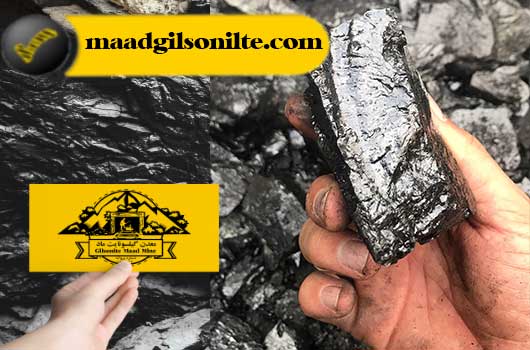
Natural bitumen, also known as asphalt or bitumen, is a naturally occurring, highly viscous, sticky substance formed from the remains of ancient marine organisms. This material is found in vast deposits around the world and has been used for thousands of years for various purposes including waterproofing, road construction and roofing.
Natural bitumen, (mineral bitumen) this type of mineral substance exists in solid or liquid form near oil sources. The reason for the formation of bitumen on the surface of the earth or in the subsurface layers of the earth is the transformation of oil over long centuries.
Also, in the past years, some crude oil reservoirs were located on the surface of the ground or near the surface of the ground, and for many years due to sunlight, light oils were emitted and bitumen, which is the heaviest element of crude oil, remained in the mine and is now used. Takes.
It should be said that mineral bitumen is formed from the evaporation of crude oil over a long period of time. The oldest natural bitumen mines, which have been exploited, were in the Jordan River Valley and around the Dead Sea (Dead Sea) and Mosul. Most of the bitumen that is consumed in America and Western Europe comes from the mines of Lake Trinidad and Bermuda. is achieved
Physical and chemical properties of natural bitumen can be different depending on their origin, properties and composition. In general, natural bitumen has high viscosity, low volatility and high density. It also has low permeability and is relatively hard and brittle at room temperature. Chemical properties can include high carbon and hydrogen content, low sulfur and nitrogen content, and a wide range of trace elements.
This widely used material, natural bitumen, has its own impurities, including sulfur minerals, etc., due to its mining location.
For example, the bitumen of the tar lake in Trinidad has about 4% sulfur and the mineral bitumen of some mines has about 1% ash, while the refining bitumen does not have ash or foreign substances. For this reason, the mineral bitumen must be processed.
In some mines, in addition to mineral bodies, bitumens contain other mixtures such as organic substances, especially plant roots, such as Trinidad bitumen, which contains 40% of mineral substances and 5% of organic substances, or Bermuda bitumen, which contains about 5% of its weight with minerals.
Regarding the difference between natural bitumen and petroleum bitumen, it should be said that petroleum bitumen or refinery bitumen is actually oil residue that is liquid. Of course, a very hard part is also found, which is called petroleum coke or petroleum coal. Two products are produced from that part, which is a very thick liquid, called vacuum baton.
When the oil contains paraffin, due to having too much paraffin and low viscosity, they do not make bitumen from it and convert it directly into fuel oil (furnace oil). If the oil has little paraffin, for example, below 4%, or this oil is mixed with lighter products such as kerosene or diesel or some kind of diluted refinery waste, which does not meet the standard of diesel, and it is produced and sold as fuel oil. .
Another method is that they give a bit of steam to the vacuum baton, and produce bitumen with small compounds from it, which is called refinery bitumen or petroleum bitumen, and this bitumen is also converted into different grades. And mostly for asphalt 70-60 or 100-85 or 100-80 that is used.
But mineral bitumen has the same characteristic in different mines, and the amount of ash determines its purity and price. For example, some Gilsonite mines have less than 5% ash.
which includes the best bitumen and reaches below ten, fifteen, twenty, thirty and even below fifty percent, the more ash mixed with it, the lower the bitumen quality. More important is separation, which is a difficult step and usually lowers the quality and price of bitumen.
A- Petroleum bitumen has less than 1% sulfur, bitumen has more sulfur. Trinidad bitumen has 3.8%, California bitumen has 3.9% and Mexican bitumen has 2.3% sulfur.
B- Petroleum bitumen is pure, mineral bitumen has mineral bodies and has up to 1% ash.
C- Refined bitumen oil is more than bitumen, refinery bitumen oil even makes up to 70% of its volume.
D. The soapy and acidic number of refinery bitumen is lower than that of mineral bitumen.
The most important difference between petroleum bitumen and natural bitumen is that most mineral bitumen is used as a modifier for refinery bitumen used in various asphalts and isogam. For this reason, due to the lack of modern bitumen processing, it is mostly used in asphalt road construction and housing.
One of the parameters of natural bitumen formation is the long passage of time, which has an effect on the process of changing the form of crude oil to natural bitumen. Natural bitumen is a black or brown mineral substance that has a variable degree of density from thick liquid to solid and glassy.
In the analysis of mineral bitumen, it was found that this material is obtained from oil distillation residue or natural oil sediment. Also, mineral bitumen is formed from hydrogen and carbon compounds with a small proportion of nitrogen, sulfur and oxygen.
This material is formed during the early stages of decomposition of marine organic deposits into oil and contains minerals. This process of transformation of crude oil causes the formation of bitumen. Mineral bitumen is formed through the change of organic materials in sedimentary rocks through the geological processes of heat, pressure and time.
This process is also known as diagenesis and occurs at a depth of about 1.5 to 6 km below the earth’s surface, where the temperature is between 60 and 220 degrees Celsius. This process usually takes millions of years and the source of organic matter can be from marine or terrestrial plants and animals.
The origin of this mineral in the past years is from crude oil, which crude oil moves to the layers of the earth’s surface, and from the slow evaporation of oil, under the influence of time, pressure, heat and also creating processes such as oxidation, sulfurization, polymerization. And condensation, bitumen is formed.
Most people think that bitumen is produced from oil in a refinery, but in some countries of the world, natural bitumen mines have been formed that were formed 360 million years ago.
During the Carboniferous period, the earth was covered with swamps and ponds, many living organisms lived in swamps, and after death for many years, the conditions for the formation of fossil fuels were created by the accumulation of sediment on the remains of these organisms.
A situation such as high pressure, lack of oxygen and high temperature that causes fermentation and chemical change of organic molecules over time. In these conditions, especially the temperature above 50 degrees Celsius, organic materials in the sediments turn into kerogen, bitumen and oil.
Today, the most natural bitumen mines in the world are in Iran, Venezuela, Oman and Canada. This type of mineral bitumen should be extracted and processed like crude oil. In some mines of the world, natural bitumen is formed at a shallow depth, such as Canadian bitumen mines, which are extracted with mining equipment.
Finally, I must say that bitumen extraction is very expensive compared to refinery bitumen. Also, natural bitumens contain up to 5% sulfur, heavy metals and impurities in some of them, which increase the cost of processing.
Insoluble and insoluble in carbon disulfide asphaltic pyrobitumen
Non-Asphaltic Pyrobitumen
and solid bitumen solution of natural bitumen or Asphaltite
Natural bitumen is commonly used in the construction industry for asphalt pavement and roofing materials. It is also used as waterproofing of concrete structures and in concrete production.
Natural bitumen has been used in traditional medicine for centuries. It is believed to have anti-inflammatory and pain-relieving properties and is used to treat conditions such as arthritis and eczema.
Due to its adhesion and waterproof properties, it is used in the production of paints and coatings. It is also used as an adhesive in lacquers and varnishes.
1- Civil works: roads, airports, sports fields, building foundations, building insulation, etc.
2- Hydraulic fields: canals, bridges, water reservoirs, dams, etc.
3- Industrial uses: metal protective coating, painting, caulking, battery making, tire making, shoemaking, underground gas pipe coating, etc. Bitumen sales
4- Agriculture: maintaining humidity, plant maturity, preventing tuberculosis and creating artificial forests, soil erosion and quicksand, etc.
5- Electrical: asphalt strips, filling electrical connections, covering wires, insulation, etc.
Bitumen is widely used in the advanced and industrial world. Normally, to use bitumen, its quality must be determined. This analysis is performed in the laboratory based on the type of application and its use.
One of the best uses of natural bitumen is its stickiness and impermeability. It is used in various industries. It is also used in the roofs of houses due to the cheap price of bitumen. But mineral bitumen is the most used. in the production of asphalt and asphalt mixtures.
In the natural bitumen test, it was found that its use in the production of isogam brings its quality to the highest level. It is also impervious to moisture and prevents heat loss inside buildings.
Due to its high quality and adhesion, bitumen is used in asphalt and road construction because it increases the durability and life of asphalt.
The use of natural bitumen can be traced back to ancient times, where it was used as a waterproofing agent for boats and structures, a sealant for jars, and a binding agent in construction.
For example, the ancient Egyptians used bitumen to embalm their dead, while the Mesopotamians used it to pave streets and build buildings. The Greeks and Romans also used gilsonite to waterproof their structures, and the Chinese used it as a building mate rial and fuel.

Types of natural bitumen reserves
Natural bitumen deposits can be classified into two types: primary deposits and secondary deposits. Primary deposits contain bitumen that is still forming, while secondary deposits contain natural bitumen that has already undergone significant alteration and degradation.
Exploration techniques
The exploration of natural bitumen requires the use of various geological and seismic techniques, including the drilling of exploratory wells, magnetic resonance imaging (MRI) and seismic tomography. These techniques help to identify the location, extent and quality of mineral bitumen deposits.
Extraction methods
Extraction of natural bitumen is done through various methods such as surface extraction, in-situ extraction and hydraulic fracturing. Surface mining involves removing the top layer of soil and rock, exposing natural bitumen deposits and extracting it using heavy machinery.
On the other hand, in-situ mining involves injecting steam into the deposit to fluidize the bitumen and allow it to be pumped to the surface. Hydraulic fracturing is another mining method that involves the use of high-pressure water and chemicals to break the rocks around the deposits.
Behbahan Bituminous Mines – Kermanshah province mines (Gilsonite Mad mine) as well as Pish-Kuh and Push-Kuh in Lorestan province, etc., are among the bitumen mines of Iran. Due to the fact that there is a lot of oil bitumen in Iran and it is produced cheaper and also its characteristics can be controlled, less attention is paid to bitumen.
Also, mineral bitumen is similar to bitumen produced from crude oil and refers to natural, non-crystalline and viscous black or dark brown hydrocarbon materials. Natural bitumen is often called asphaltite (pure bitumen).
As the demand for natural bitumen increases, the discovery of new reserves becomes more vital. More research is needed to identify new reserves and understand their economic potential.
New mining techniques are also on the horizon. Technologies that optimize the extraction process and minimize environmental impact are being developed. These techniques can reduce the extraction cost and make natural bitumen more competitive in the market.
Transportation of mineral bitumen should be done with great care, different qualities of bitumen should be separated and stored separately. In the storage place of different bitumen, there should be an analysis according to the requested product. Also, when loading in trucks, it should be covered with a waterproof tent to prevent rainwater or snow from entering the product.
The important point in storing bitumen in the warehouse is that there must be ventilation and ventilation to prevent the accumulation of flammable gases. Bitumen warehouses must be kept away from flammable materials, and fire safety equipment must be installed in advance. provided
Natural bitumen, also known as asphalt or bitumen, is a natural substance that forms through geological processes and is found in deposits around the world.
Natural bitumen is used in various industries such as construction, road construction, waterproofing and mining. It is also used in traditional medicine and is known for its healing properties.
Yes, natural bitumen has high chemical resistance and is resistant to oxidation, ultraviolet rays and high heat.

